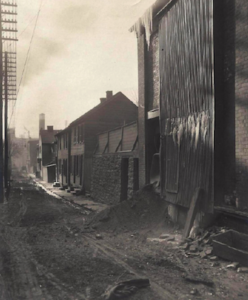
Tanners Alley near Walnut Street in the early 1900s.
*Harrisburg, PA, was chartered on March 19, 1860. This date is used because this city is home to Tanner’s Alley, a section of Harrisburg that played a part in the abolition movement during American slavery.
Settled around 1719, the city was a stop on the Underground Railroad, where runaway slaves were fed and clothed on their way to Canada. Harrisburg is less than an hour from the Mason-Dixon Line and was home to 900 free Blacks by 1850 (12% of the city’s population). Much of this population lived on a 500-foot road nicknamed Tanner’s Alley.
This neighborhood was home to some of the poorest residents in the city. High-skilled professionals were seldom found here, while unskilled service workers were common. While facing the hardships of racism and poverty, this neighborhood was home to a Black Masonic Hall and Wesley Union A.M.E. Zion Church, Harrisburg’s first Black church founded in 1816. Many slaves were hidden in Tanner’s Alley by notable Underground Railroad conductor Joseph Bustill and Dr. William “Pap” Jones, a well-known doctor and merchant that lived a block from Bustill.
Today, Tanner’s Alley lies between Walnut Street and South Street, while Wesley Union A.M.E. Zion Church still has its doors open.